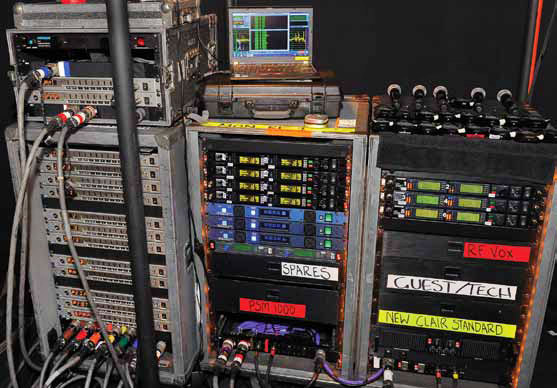
Wonderful Experience
For the few who haven’t guessed, Natale is a dedicated analog devotee. “I don’t care about hardware. I just want an analog console, 100 percent analog, because it won’t do anything until I tell it to. I don’t want any logic in the desk, which is why I use a (Yamaha) PM4000. This allows me to spend most of my time mixing. If it takes water, as we’re often outdoors, then what type of desk do you think I can bring back to life quickest?” A 24-input Midas Venice 320 serves as a sidecar for choir mics.
“We often have guest performers on this tour, and I never know who the guest is until the afternoon of the show,” he continues. “We reserve one input for the guest’s guitar with a wired 57, and one input for their vocal with a wireless 58. The guest vocal is the only input I regularly use a compressor on. We’ve had Katy Perry, Gwen Stefani, Brad Paisley, Bonnie Raitt, Taj Mahal, Gary Clark Jr., Taylor Swift, Carrie Underwood, Jeff Beck, John Mayer, John Fogerty, and Tom Waits.”
This was probably the first show this writer has heard in decades that did not use compressors or gates in some manner, and it was a wonderful experience. Natale has a single dbx 900 rack under his console. dbx 903 modules are patched on the bass DI, Mick’s number 1 vocal, Mick’s number 2 vocal, Keith’s vocal, BV number 1, BV number 2, and the guest vocal channels. Three Aphex 612 gates are patched on the kick, rack, and floor tom channels.

However, none of these devices were engaged, not even the compressor on Mick’s vocal. I can testify that no indicators were moving during the show. While any red-blooded engineer would question how Natale is able to effectively manage gain levels, he appreciates that the opportunity cost of using inserts to manage those levels is lost leading-edge transient response. Instead, he chooses to stay very active during the show, relying on the consistency of the performers. His adjustments are in response to the many required cues as dictated by each song, while retaining a natural transience in his input channels that I found so refreshing.
I detected no “blanket” over the sound or processing getting in the way, only the occasional peak of a given voice or instrument. The occasional peak seemed like a reasonable price to pay considering how accurate everything sounded. I honestly believe that Charlie Watts’ drums were the most real sounding I have ever heard in an arena.
“I’m not at all into vintage gear because I do not believe we need special equipment to enhance what’s coming from the stage,” Natale states. “No boutique microphones; we’re all about choosing what is easily accessible, reliable, and known to sound good. We’re using Shure SM57s and 58s, Sennheiser 409s, Neumann KM 184s, and two AKG C 414s. If we need a replacement we can go to the music store down the street. In fact I joke about the fact that if you added up the total cost for wired microphones on this tour it might not exceed $5,000.” He also specifies Radial DIs exclusively.

“I’m not even using reverb. I’m relying on the million cubic feet of (natural) reverb right here in the arena,” he adds. “It’s really clean and sounds better than digital, but doesn’t hiss like analog. Outdoors is another story. In bone dry, uncontained free air I’ll obviously need something, at least on the slower songs.
“But only one reverb on one innocuous program that adds something you can almost not even hear. However, everything goes through the same program so it sounds like the whole band is playing in the same space. It’s not so much an effect as trying to create an environment we’re not in.”
